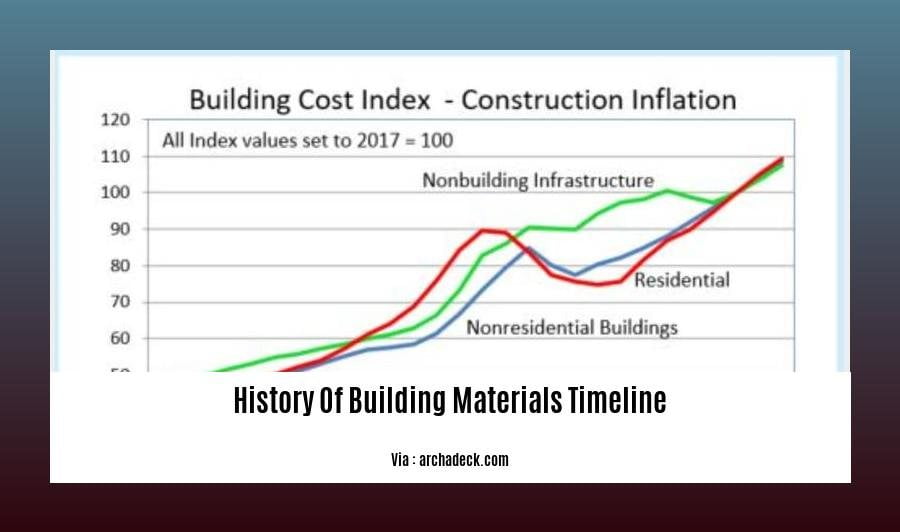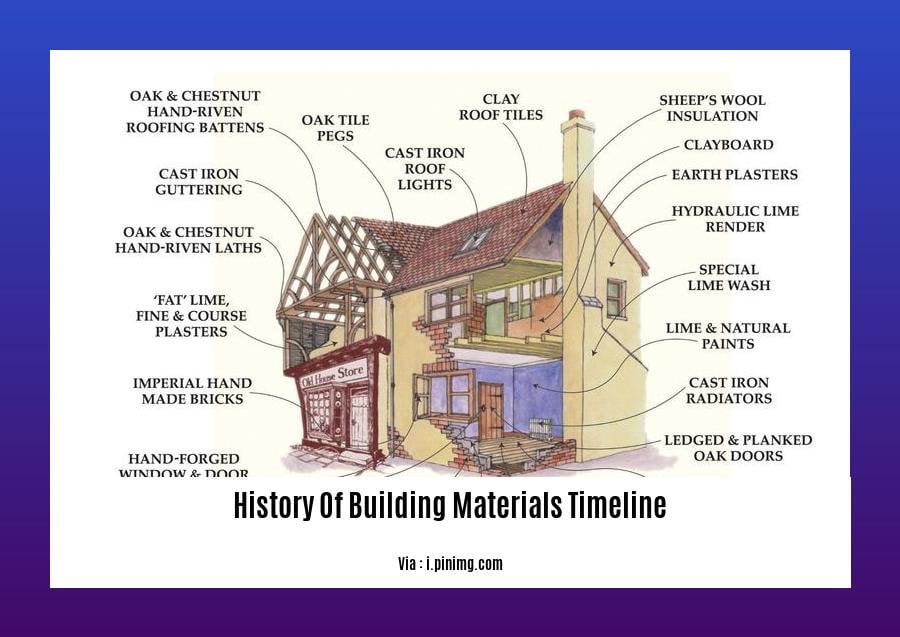Welcome to a captivating historical journey through the evolution of building materials! From the rudimentary use of natural elements to the marvels of modern technology, our exploration unveils the profound impact of innovation and tradition on the construction industry. Join us as we traverse a timeline of remarkable discoveries, where ordinary materials transformed into architectural wonders, shaping the foundations of our built environment.
Key Takeaways:
- Bricks were first used in Mesopotamia around 2000 BC.
- Ancient builders relied on natural materials like stone, clay, and wood.
- New materials emerged during the Industrial Revolution, enabling taller and larger structures.
- Modern construction utilizes synthetics and composites for enhanced durability and performance.
History of Building Materials Timeline

From ancient civilizations to modern skyscrapers, building materials have played a crucial role in shaping our built environment. This timeline takes us on a captivating journey through history, exploring the evolution of construction methodologies and the materials that have transformed architecture:
10,000 BC – 5000 BC: The Dawn of Construction
- The earliest known structures were built using natural materials like wood, stone, and mud.
- Humans began to settle in permanent dwellings, leading to the development of basic construction techniques.
3500 BC – 1500 BC: The Rise of Masonry
- The invention of fired bricks in Mesopotamia marked a significant advancement in building technology.
- Bricks offered greater durability and allowed for the construction of more complex structures.
- The use of stone masonry also became widespread, as seen in the impressive pyramids of ancient Egypt.
500 BC – 1 AD: Classical Architecture and Concrete
- The Greeks and Romans made significant contributions to architecture, developing classical orders and refining the use of concrete.
- Concrete, a mixture of lime, sand, and aggregate, revolutionized construction by enabling the creation of arches, domes, and vaults.
500 AD – 1500 AD: Medieval Innovations
- The Middle Ages saw the rise of Gothic architecture, characterized by pointed arches, ribbed vaults, and flying buttresses.
- The use of timber framing became popular in Europe, allowing for the construction of taller and more complex structures.
1500 AD – 1800 AD: The Renaissance and Baroque Periods
- The Renaissance witnessed a revival of classical architecture, with an emphasis on symmetry, proportion, and ornamentation.
- Baroque architecture followed, characterized by its elaborate and dynamic forms, often using materials like marble and stucco.
1700 AD – 1900 AD: The Industrial Revolution and New Materials
- The Industrial Revolution brought about the development of new building materials, including cast iron, steel, and concrete.
- These materials enabled the construction of larger and taller structures, such as skyscrapers and bridges.
- Glass and steel became popular for facades, creating a new aesthetic in architecture.
1900 AD – Present: Modern and Contemporary Architecture
- The 20th century saw the rise of modern architecture, characterized by its simplicity, functionality, and use of new materials.
- Concrete, steel, and glass continued to dominate construction, but new materials like plastics and composites emerged.
- Contemporary architecture embraces sustainability, incorporating energy-efficient materials and green building practices.
The history of building materials timeline is a testament to human ingenuity and the constant quest for new and innovative ways to construct our built environment. From ancient mud bricks to modern composites, materials have played a pivotal role in shaping the world we live in, reflecting both technological advancements and cultural values.
- If you’re curious about the history of Brazilian Jiu Jitsu, then click this link to learn how it developed.
- Looking to learn about the history of pubs in Britain? Visit our page here to find out more.
- Ever wondered about the history of Callaway drivers? Click here to explore their journey.
Medieval Advancements: Innovation in Europe during the Middle Ages, with a focus on brickwork, stained glass, and the development of the Gothic style.
The Middle Ages (5th-15th centuries) were a vibrant and transformative era marked by significant advancements in architecture and construction in Europe.
During this period, innovations in brickwork, stained glass, and the rise of the Gothic style reshaped the built environment, leaving a lasting impact on the building industry.
Here are key developments that revolutionized medieval architecture:
- Brickwork:
- The Romans developed the art of bricklaying, and its resurgence in the Middle Ages brought with it the construction of sturdy and durable buildings.
- Advancements in brick-making techniques resulted in the production of uniform, high-quality bricks, creating a new aesthetic for medieval architecture.
Brickwork allowed for the creation of intricate patterns and decorative moldings, adding a level of sophistication to structures such as churches and castles.
Stained Glass:
- The invention of stained glass brought a new dimension of art and color to medieval buildings.
- The vibrant hues and intricate designs of stained glass windows illuminated interiors with beautiful patterns and narratives from the Bible.
Stained glass also served a functional purpose, filtering sunlight and providing privacy, while transforming the indoor atmosphere with a sacred and awe-inspiring aura.
Gothic Style:
- Emerging in the 12th century, the Gothic style revolutionized the way buildings were constructed.
- Its characteristic features, including pointed arches, ribbed vaults, and flying buttresses, allowed for the creation of taller, more spacious structures.
- The Gothic style emphasized light and verticality, creating a sense of elevation and lightness in cathedrals and other religious buildings.
- The intricately carved decorations on Gothic facades celebrated biblical stories and reflected the era’s religious fervor.
Key Takeaways:
– Brickwork innovations led to more durable buildings and intricate decorative elements.
– Stained glass brought color, art, and religious symbolism into medieval architecture.
– The Gothic style revolutionized construction with its emphasis on height, light, and structural innovations.
Relevant Sources:
– 10 Great Inventions of the Middle Ages
– Medieval Inventions
Industrial Revolution and Modernization: The Impact on Building Materials

The Industrial Revolution marked a radical transformation in societal and economic structures, ushering in the era of mass production and mechanized processes. This revolution had a profound impact on the world of building materials.
Steel: The Backbone of Modern Structures
Steel, an alloy composed primarily of iron, emerged as a game-changer in architecture during the Industrial Revolution. Bessemer’s invention of the converter and the open-hearth furnace revolutionized steel production, making it possible to mass-produce this robust and versatile material. Steel’s superior strength and ability to withstand heavy loads made it an ideal choice for constructing bridges, skyscrapers, and other large structures.
Concrete: The Foundation of Modern Cities
Concrete, a composite material made from cement, sand, and aggregate, also gained prominence during this era. Concrete’s durability, affordability, and ease of molding made it a popular choice for building foundations, roads, bridges, and dams. The invention of reinforced concrete, where steel bars are embedded in concrete, further enhanced its strength, making it suitable for constructing tall buildings and other complex structures.
Glass: A Window to the Modern World
The Industrial Revolution also witnessed significant advancements in glass production. The invention of the cylinder blowing machine and the Fourcault process enabled the mass production of large, flat sheets of glass, making it more affordable and accessible. Glass quickly became an essential material for windows, skylights, and other architectural features, transforming how buildings interacted with natural light and creating brighter, more spacious interiors.
Key Takeaways:
- The Industrial Revolution transformed building materials with mass production and technological advancements.
- Steel became a vital material for bridges and skyscrapers due to its strength and durability.
- Concrete gained popularity for foundations, roads, and dams due to its affordability and strength.
- Glass became more accessible with mass production, transforming building aesthetics and functionality.
Relevant Sources:
- [The History of Steel](
- [The History of Concrete](
Sustainability and the Future: Contemporary concerns for environmental impact and resource conservation, driving the adoption of sustainable materials and green building practices.
In the ever-evolving narrative of architecture, the focus on sustainability has emerged as a dominant theme, driven by the pressing challenges of environmental impact and resource conservation. This contemporary concern has set the stage for a material revolution, prioritizing sustainable building materials and green building practices that minimize the ecological footprint of our built environment.
Key Takeaways:
- The construction industry contributes significantly to global carbon emissions, making it imperative to adopt sustainable practices to mitigate its environmental impact.
- Sustainable building materials and green building techniques play a vital role in reducing resource consumption and promoting energy efficiency.
- Life-cycle assessment (LCA) and material transparency are key considerations in selecting sustainable construction materials.
- Embracing sustainable building practices requires collaboration among architects, engineers, material suppliers, and policymakers.
- LEED certification and other green building rating systems serve as valuable tools for assessing and recognizing sustainable building projects.
As our comprehension of the environmental consequences of traditional building methods deepens, sustainable alternatives are expanding across the industry. These contemporary materials and practices not only reduce carbon emissions but also improve indoor air quality, promote water conservation, and adapt to the changing climate. From energy-efficient designs to green building codes, from waste reduction strategies to the reuse of recycled materials, innovative practices are pushing the boundaries of sustainable construction.
Sustainable Materials: The Cornerstones of Green Building
At the heart of sustainable building lies the selection of materials. Sustainable materials are those that minimize environmental impacts throughout their life cycle, from extraction and production to use and disposal. To evaluate the sustainability of a material, a life-cycle assessment (LCA) is conducted to assess its environmental performance.
Some of the most commonly used sustainable building materials include:
Recycled and reclaimed materials: These materials, such as recycled steel and reclaimed wood, reduce the need for virgin material extraction and minimize waste.
Bio-based materials: Natural, renewable materials like bamboo, hemp, and straw fibers offer sustainable alternatives to traditional building materials.
Low-carbon materials: Materials with a low embodied carbon, such as rammed earth, cellulose insulation, and cross-laminated timber, sequester more carbon dioxide than they emit during production and installation.
Rapidly renewable materials: These materials, such as bamboo and fast-growing grasses, can be replenished quickly, minimizing their environmental impact.
Green Building Practices: Beyond Material Selection
Sustainable building extends beyond material selection to encompass the entire construction process. Green building practices aim to optimize the energy efficiency of a structure, minimize its environmental impact, and create a healthier indoor environment.
Energy efficiency measures: These strategies, such as proper insulation, high-performance windows, and energy-efficient appliances, reduce a building’s energy consumption.
Water conservation practices: Water-efficient fixtures, rainwater harvesting systems, and greywater reuse strategies help conserve this precious resource.
Waste management: Comprehensive waste management plans minimize the environmental impact of construction and demolition waste.
Site selection and planning: Choosing a site that minimizes the need for extensive excavation and grading, and optimizing the building’s orientation to take advantage of natural light and ventilation, can significantly reduce environmental impacts.
The Future of Sustainable Building: Innovation and Collaboration
As the world navigates the challenges of climate change and resource depletion, the construction industry must continue to innovate and explore new approaches to sustainable building. Advances in material science, such as the development of bio-based and carbon-negative materials, hold immense promise for the future.
Collaboration among architects, engineers, material suppliers, and policymakers is essential to accelerate the adoption of sustainable building practices. Green building rating systems, such as LEED and BREEAM, provide valuable frameworks for assessing and recognizing sustainable building projects, driving the industry towards a more sustainable future.
Sustainability is not just a buzzword; it is a fundamental necessity for the future of our planet. By embracing sustainable building materials and practices, the construction industry can play a pivotal role in mitigating climate change, conserving resources, and creating a healthier, more sustainable built environment for generations to come.
Sources
[1]
[2]
FAQ
Q1: What were the first building materials used by humans?
A1: Ancient humans primarily relied on naturally occurring materials such as stone, clay, and wood for construction. Bricks made from clay were among the earliest building materials, with their first recorded use dating back to 2000 BC in Mesopotamia.
Q2: How did the Industrial Revolution impact the development of building materials?
A2: The Industrial Revolution brought about significant advancements in building materials. New materials like cast iron, steel, and concrete were introduced, enabling the construction of larger and taller structures. These materials revolutionized architecture and paved the way for modern construction techniques.
Q3: What are some of the key factors that have influenced the evolution of building materials?
A3: The evolution of building materials has been shaped by various factors, including technological advancements, cultural context, and sustainability. Technological innovations have introduced new materials and construction methods, while cultural preferences and architectural styles have influenced the choice of materials. Sustainability concerns have also driven the development of eco-friendly and energy-efficient building materials.
Q4: What are some examples of traditional building materials that are still widely used today?
A4: Many traditional building materials have stood the test of time and continue to be used in modern construction. Stone, clay bricks, and wood remain popular choices due to their durability, versatility, and aesthetic appeal. Traditional materials like bamboo and thatch are also gaining renewed interest for their sustainable properties and cultural significance.
Q5: How can we ensure that future building materials are both innovative and sustainable?
A5: To achieve a sustainable future in construction, it is crucial to embrace innovative building materials that minimize environmental impact. This can involve using recycled and renewable materials, developing energy-efficient construction methods, and incorporating green technologies into building designs. By prioritizing sustainability, we can create buildings that are not only innovative but also contribute to a healthier planet.
- Mastering Leader in Spanish: The Complete Guide - April 19, 2025
- Uncovering Surprising Parallels: England Size Compared to US States - April 19, 2025
- Old Mexico Map: Border Shifts 1821-1857 - April 19, 2025
















